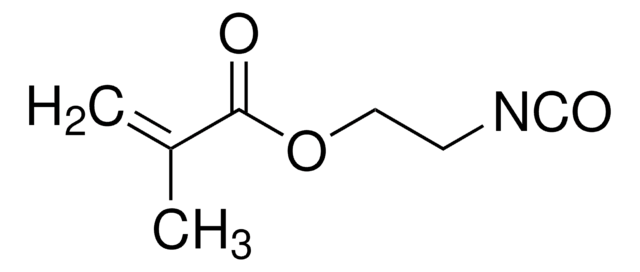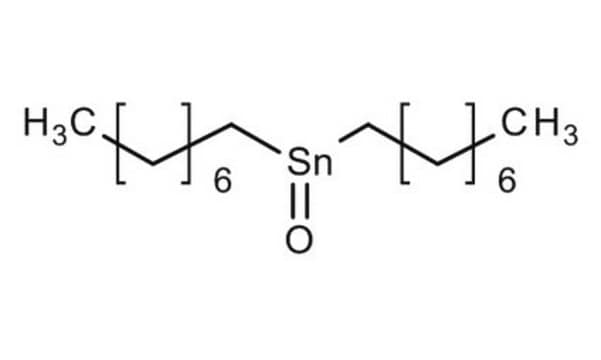If this product has an expiration or retest date, it will be shown on the Certificate of Analysis (COA, CofA). If there is no retest or expiration date listed on the product's COA, we do not have suitable stability data to determine a shelf life. For these products, the only date on the COA will be the release date; a retest, expiration, or use-by-date will not be displayed.
For all products, we recommend handling per defined conditions as printed in our product literature and website product descriptions. We recommend that products should be routinely inspected by customers to ensure they perform as expected.
For products without retest or expiration dates, our standard warranty of 1 year from the date of shipment is applicable.
For more information, please refer to the Product Dating Information document: https://www.sigmaaldrich.com/deepweb/assets/sigmaaldrich/marketing/global/documents/449/386/product-dating-information-mk.pdf
Wichtige Dokumente
291234
Dibutylzinndilaurat
95%
Synonym(e):
DBTDL
Größe auswählen
Größe auswählen
About This Item
Empfohlene Produkte
Dampfdruck
0.2 mmHg ( 160 °C)
Qualitätsniveau
Assay
95%
Brechungsindex
n20/D 1.471 (lit.)
Dichte
1.066 g/mL at 25 °C (lit.)
SMILES String
CCCCCCCCCCCC(=O)O[Sn](CCCC)(CCCC)OC(=O)CCCCCCCCCCC
InChI
1S/2C12H24O2.2C4H9.Sn/c2*1-2-3-4-5-6-7-8-9-10-11-12(13)14;2*1-3-4-2;/h2*2-11H2,1H3,(H,13,14);2*1,3-4H2,2H3;/q;;;;+2/p-2
InChIKey
UKLDJPRMSDWDSL-UHFFFAOYSA-L
Suchen Sie nach ähnlichen Produkten? Aufrufen Leitfaden zum Produktvergleich
Verwandte Kategorien
Allgemeine Beschreibung
Anwendung
- The synthesis of polyurethane (PU) and polyhydroxyurethane (PHU) prepolymers and lignin urethane. [2] [3]
- A protocol for the covalent attachment of poly(ethylene glycol) (PEG) to silicon oxide to form a hydrophilic non-fouling surface.[4]
- Preparation of polymers by reacting hydroxyl-terminated macromonomers and aliphatic diisocyanates.[5][6][7][8]
Signalwort
Danger
Gefahreneinstufungen
Aquatic Acute 1 - Aquatic Chronic 1 - Eye Irrit. 2 - Muta. 2 - Repr. 1B - Skin Sens. 1 - STOT RE 1 - STOT SE 1
Zielorgane
thymus, thymus,Immune system
Lagerklassenschlüssel
6.1C - Combustible acute toxic Cat.3 / toxic compounds or compounds which causing chronic effects
WGK
WGK 3
Flammpunkt (°F)
372.2 - 379.4 °F - closed cup
Flammpunkt (°C)
189 - 193 °C - closed cup
Persönliche Schutzausrüstung
Eyeshields, Faceshields, Gloves, type ABEK (EN14387) respirator filter
Hier finden Sie alle aktuellen Versionen:
Besitzen Sie dieses Produkt bereits?
In der Dokumentenbibliothek finden Sie die Dokumentation zu den Produkten, die Sie kürzlich erworben haben.
Kunden haben sich ebenfalls angesehen
-
How can I determine the shelf life / expiration / retest date of this product?
1 answer-
Helpful?
-
-
How is shipping temperature determined? And how is it related to the product storage temperature?
1 answer-
Products may be shipped at a different temperature than the recommended long-term storage temperature. If the product quality is sensitive to short-term exposure to conditions other than the recommended long-term storage, it will be shipped on wet or dry-ice. If the product quality is NOT affected by short-term exposure to conditions other than the recommended long-term storage, it will be shipped at ambient temperature. As shipping routes are configured for minimum transit times, shipping at ambient temperature helps control shipping costs for our customers. For more information, please refer to the Storage and Transport Conditions document: https://www.sigmaaldrich.com/deepweb/assets/sigmaaldrich/marketing/global/documents/316/622/storage-transport-conditions-mk.pdf
Helpful?
-
-
What is the concentration of item 291234?
1 answer-
The concentration (Molarity) of item 291234 can be calculated using the formula: Density x Volume x Concentration / Molecular weight = Molarity. For example, if the density is 1.066g, the volume is 1000, and the molecular weight is 631.59, the resulting molarity would be 1.69M.
Helpful?
-
Active Filters
Unser Team von Wissenschaftlern verfügt über Erfahrung in allen Forschungsbereichen einschließlich Life Science, Materialwissenschaften, chemischer Synthese, Chromatographie, Analytik und vielen mehr..
Setzen Sie sich mit dem technischen Dienst in Verbindung.

















